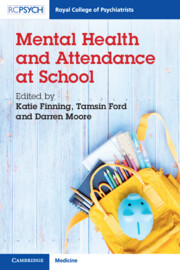Book contents
- Mental Health and Attendance at School
- Mental Health and Attendance at School
- Copyright page
- Contents
- Contributors
- Preface
- Acknowledgements
- Chapter 1 Mental Health and Attendance at School
- Chapter 2 School Attendance
- Chapter 3 Emotional Disorders and Attendance at School
- Chapter 4 Behavioural Disorders and Coping with School
- Chapter 5 Neurodevelopmental Disorders and Attendance at School
- Chapter 6 Educating a ‘New Me’ after an Acquired Brain Injury
- Chapter 7 School Influences on Attendance and Special Educational Needs
- Chapter 8 Supporting the Attendance of Vulnerable Children at School
- Chapter 9 School Attendance and Anxiety
- Chapter 10 Reflections on the Impact of Covid-19 on Children’s Education and Mental Health
- Index
- References
Chapter 8 - Supporting the Attendance of Vulnerable Children at School
A Lens on Refugee Children and Those with Life-Limiting Illnesses
Published online by Cambridge University Press: 24 March 2022
- Mental Health and Attendance at School
- Mental Health and Attendance at School
- Copyright page
- Contents
- Contributors
- Preface
- Acknowledgements
- Chapter 1 Mental Health and Attendance at School
- Chapter 2 School Attendance
- Chapter 3 Emotional Disorders and Attendance at School
- Chapter 4 Behavioural Disorders and Coping with School
- Chapter 5 Neurodevelopmental Disorders and Attendance at School
- Chapter 6 Educating a ‘New Me’ after an Acquired Brain Injury
- Chapter 7 School Influences on Attendance and Special Educational Needs
- Chapter 8 Supporting the Attendance of Vulnerable Children at School
- Chapter 9 School Attendance and Anxiety
- Chapter 10 Reflections on the Impact of Covid-19 on Children’s Education and Mental Health
- Index
- References
Summary
School systems and staff can play a key role in supporting the most vulnerable children, not only at the key moment of school entry/introduction but also throughout their time at the school. This chapter highlights the importance of understanding the background experience of children who are not thriving at school, helping them feel welcome and settled at school and finding ways, through the structured and unstructured educational opportunities provided at school, to help these children feel a sense of belonging and enhanced self-esteem within the school system. The chapter highlights the needs of two different subgroups of children: those with chronic health problems and refugee children. The need to consider the role the school can play to support families is discussed.
Keywords
- Type
- Chapter
- Information
- Mental Health and Attendance at School , pp. 145 - 161Publisher: Cambridge University PressPrint publication year: 2022



